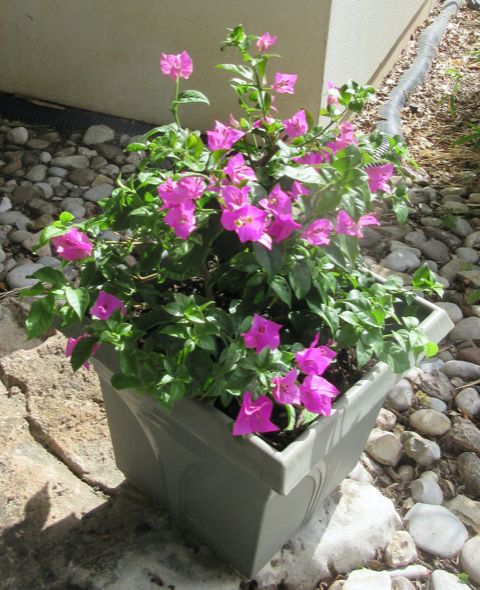By CMG Kathleen S

Bougainvillea
I am sure I am not the only gardener seriously rethinking my planting strategies. The outrageous heat wave and the drought––we are close to Stage 3 watering restrictions––have caused me to look at other solutions. Bougainvillea is one of my solutions.
I needed a container planting in front of my church’s sanctuary. I went to one of my favorite nursery haunts and found a nice selection of red, white, and purple. Bougainvilleas are also available in pink, orange, and yellow. The colorful parts that look like flowers are actually bracts that surround the tiny true flowers.
Bougainvillea are very versatile. Stems are thick and rather stiff. At least one variety can extend up to 40 feet in length. Other varieties grow from 3 to 30 feet. These plants can be used to accent a garden archway, provide privacy for a patio, or drape over a garden wall. Some varieties are perfect for container gardening. Some varieties do have thorns.
The plant gets its name from Admiral Louis A. Bougainville, a French explorer who came across the plant in South America in the 1700s. It is part of the Nyctaginaceae family, more commonly known as the four o’clock family. This plant is native to Central and South America and it can be found growing happily in South Florida, Arizona, South Texas, and Southern California (growing zones 9b–11). Comal County is in growing zone 8b.
Bougainvillea are tolerant of only light frosts, but not temperatures below 30 degrees. If planted outside, Bougainvillea will need to be covered during winter weather. (I like to wrap lighted Christmas lights around my cold-sensitive plants.)
Bougainvillea require at least 6 hours of sunlight and loose, gritty soil. Do not use peat moss. These plants are very suspectible to root rot. A little water goes a long way. Instead of frequent shallow waterings, give the plants a deep watering every 3 to 4 weeks––to the point that water is running out of the bottom of the pot. Water only when the soil around your plant is dry down to 1 inch deep.
There are several products specifically produced for Bougainvillea and flowering vines. Different manufacturers may have a different balance of N-P-K and application instructions. Be sure to read the labels.
They bloom on new growth and flower periodically throughout the year, most profusely in winter and spring. Pruning should be done at the end of winter/beginning of spring, before the plant begins to make buds for new blooms. Remove any dead or discolored stems. Be sure to use rubbing alcohol or disinfectant on your pruning shears after each stem has been cut.
Blooms are cyclic with periods of rest between each profusion of blooms. Pinch pruning can be done as soon as blooms have faded. Please remember that the roots of Bougainvillea are very fragile. Be sure to handle carefully when transplanting and, if you are using a trellis, put the trellis behind the plant at the time of planting.
Bougainvillea are mostly pest and disease free but can be attacked by aphids, fungal leaf spots, snails, and slugs.